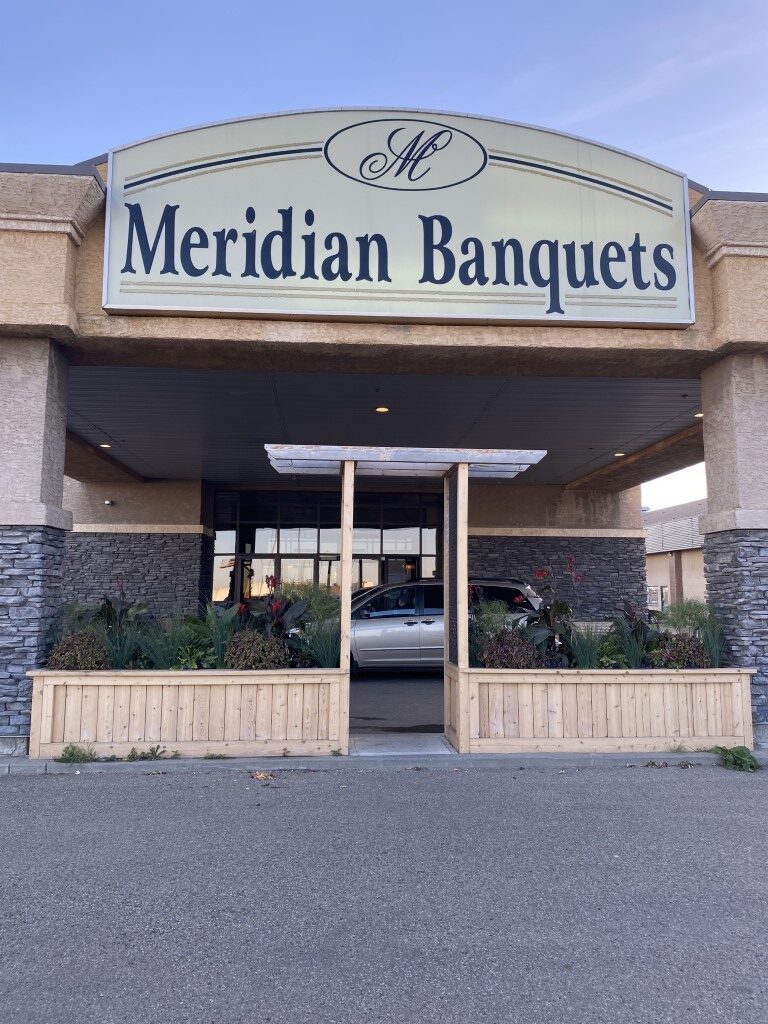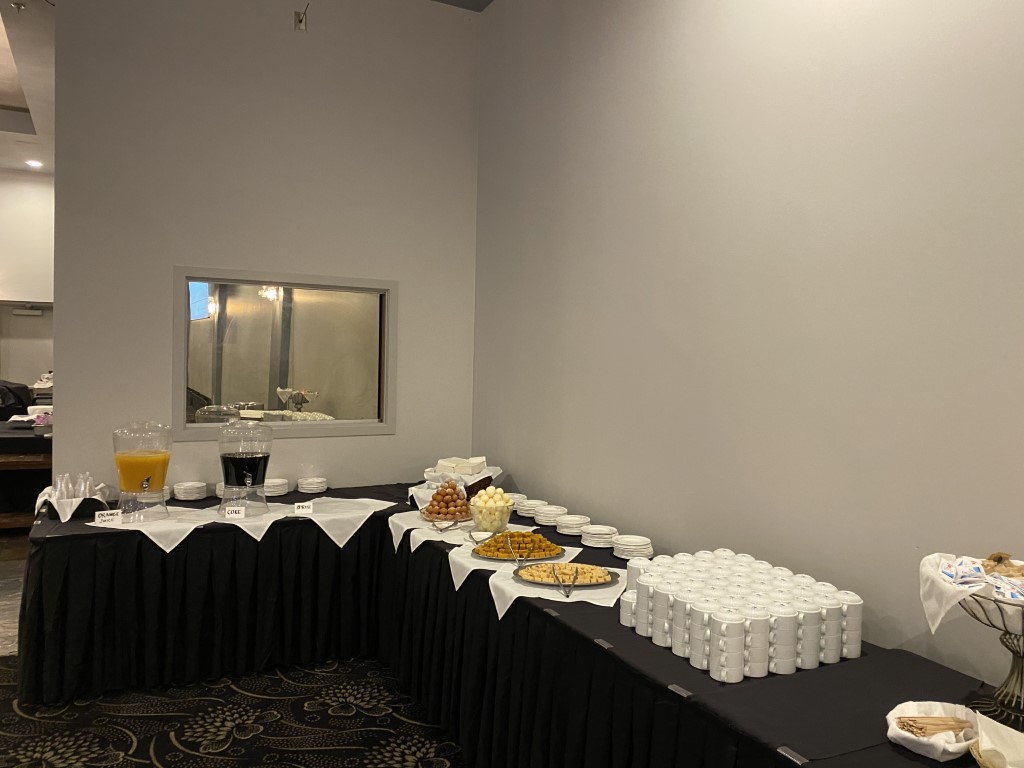
Photos and report by J. Kaur
Entering the Meridian Banquet Hall, the first thing I checked for was whether my friends and I had overdressed for the event. Thankfully, there were guests walking in dressed to the nines. My pastel coloured floral Punjabi suit paled in comparison and so did my friends’ light pink frock suit and Gujarati style gown. Clearly, we had decided to play it safe while the other women were there to impress. There were flowing silk sarees, gowns glittering in vibrant colours, elegant looking hijabs, and sparkling sequins. So. Many. Sequins. A woman caught our attention as her entire saree looked like it was dripping in crystals that sparked under the light whenever she moved.
We were there to attend the Interfaith Multicultural Celebration, an event hosted by the Shamma Center for community members to celebrate each others’ faiths. The Shaama Centre is a community centre for seniors and women, especially those struggling with social and physical barriers. It provides a number of services such as English classes, basic computer courses, and counselling. The 23rd annual Interfaith Multicultural Celebration was hosted on October 14 and the theme for this year was “Stories of Identity and Intersection”. The ticket price ranged from $32 – $50, depending on how far in advance they were bought.

Since it was my first Interfaith Multicultural Celebration, I went with an open mind. The first half hour of the event was to mingle and enjoy the appetizers. I sat at a table with my friends, curious about the other guests. The attendees were all women of varying ages and backgrounds. There were middle aged women sitting in clusters at different tables, saying their hellos and admiring each others’ outfits. A table in the corner was occupied by a group of elderly women, white hair peeking out from under their hijabs or dupattas, wearing less vibrant but elegant looking traditional dresses. Laughter rang out from their table every so often. Teenagers and young women accompanied their mothers and grandmothers, greeting each other with a shy smile and a wave while their mothers embraced. I could hear conversations in different languages, recognizing words here and there in Punjabi or Hindi.
It would be a crime to not speak about the food. There were plenty of both vegetarian and non-vegetarian options. I was delighted by the mini samosas, placing them on my plate with crunchy spring rolls and spicy chilli paneer. My friend promised me the honey-fried cauliflower would be amazing, and she was right. I bit into a firm and flavourful piece, enjoying the burst of sweet and spicy flavour. There was a separate table for the sweets with plump gulab jamuns, perfectly cut barfi, and sweet rasgulla. The rasgulla in particular were mouthwatering, the airy dough completely saturated with sweet syrup. Later in the evening, they also added cha to the table, which is a must have for an event that involves brown people.




An elderly hijabi woman was sitting at our table and she was curious enough about us to ask questions. She was particularly delighted to hear about our future career plans, giving her blessing and revealing she used to work as a graphic designer. There was also a group of middle-aged ladies at our table. Lovely as they were, they were also very chatty. At one point, someone asked them to quieten down for the speech, but clearly nothing was going to stop these women. That seemed to be a common theme throughout the room. As the speeches began, many of the guests seemed more interested in their table partners than the stage.
The first speech was presented by the Sikh speaker, Surjit Dhaliwal, something I was excited for, being a Sikh myself. However, I was disappointed as it would have been appropriate to have a translator present. I strained to hear her through the deafening conversations around me and the presenter’s own discomfort with English. It seemed a disservice to her and the powerful speech she had prepared, snippets of which were spoken quite well in Punjabi. It touched on the principles of Sikhi that support community and equality.
There were also Jewish, Indigenous, Muslim, Hindu, and Christian speakers. I enjoyed the presentation by Chaplain Ibrahim Long, the only man present, as he humorously pointed out. He emphasized the importance of one’s own community but also of different communities coming together to support each other, regardless of faith. He quoted the Quran and reached into the experiences of other cultures to make his points. He brought photographs of old gathering sites, expanding on the significance of places where people can physically come together. It also helped that he was loud enough to drown out the voices of the guests who were chatting. It was impossible to compete with his booming voice. Sensing a worthy competitor, even the ladies at our table turned in their chairs to give him their attention.
I also enjoyed the presentation by the Indigenous speaker, Sissy Thiessen, who spoke confidently and comfortably. She spoke of amiskwaciwâskahikan (Edmonton) Indigenous history and the current affairs in the Indigenous community. She also encouraged people to come together and get involved, both to support Indigenous communities and the environment. I appreciated the specific examples of organizations we could look into such as Water First and Shannen’s Dream.



Unfortunately, this wasn’t as tempting to the aunties sitting at my table as they continued to talk. Sissy Thiessen remarked on how children in classrooms are better behaved but as far as scolding remarks go, it barely made a difference. I was torn between paying attention to the speakers and trying not to eavesdrop on the thrilling gossip beside me.
The event would have benefited from amplifying the voices of the presenters. The room felt too big for the speakers, making it easier for guests to talk over them. While it was a great idea to have the screens set up around the hall projecting slideshows, having the live camera recording playing on the screen would have been more engaging and also made it easier to see the performances and the speakers.
The performances interspersed between the speeches were sparse but engaging. Sissy Thiesen performed a Pow wow dance, during which everyone silently and respectfully watched the traditions of a culture I assume most people in the room weren’t familiar with. Sally’s group, a Chinese dance group consisting of young ladies, performed two dances for us; the Chinese classical Chai Wei and the Chinese Butterfly Dance. There were also two fashion shows at the end to display beautifully designed cultural clothing. A majority of the attendees were immigrants, from an older generation, or from a different faith. Performances are a powerful and inviting way to appreciate cultures we aren’t familiar with. My only gripe is that I was expecting more performances, maybe even a Bhangra performance to turn the crowd’s energy from talking to wanting to dance.
At the end of the speeches and cultural dances, it was time for dinner. My friend remarked that appetizers are often better than dinner. She was right because even though the dinner was delicious, it couldn’t measure up to the appetizers. I enjoyed a plate of naan and rice with shahi paneer and dahi, though the seasoning was surprisingly lacking in the shahi paneer. The pasta tasted a little undercooked but it went nicely with the well seasoned greek salad.
By the time we left the event, we were feeling full from all the food and warm from the experience we’d just had. I even left appreciating the chatty aunties at my table because while the event was educational, it was foremost a social space. I don’t often get to wear a Punjabi suit for an evening with my friends or mingle in such a diverse crowd where everyone can fully embrace their culture. It was also nice to confirm that language or faith is no barrier to gossip, especially the juicy kind.

